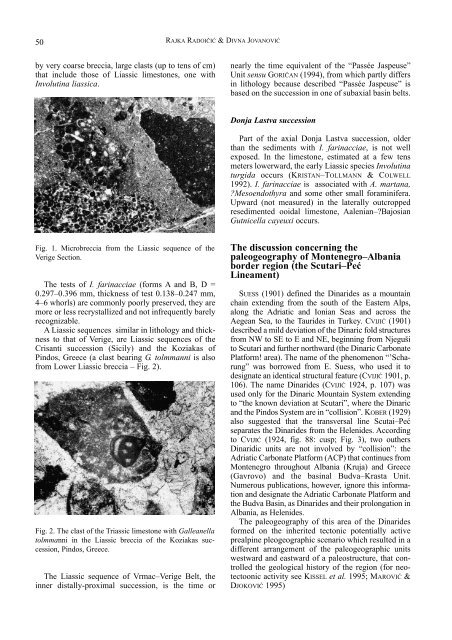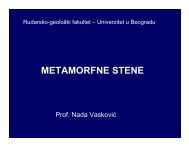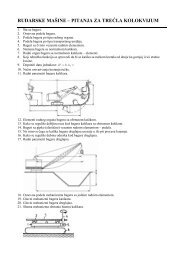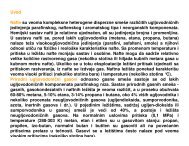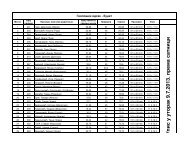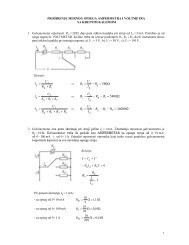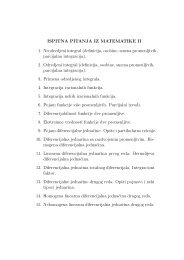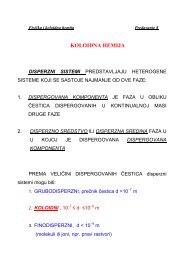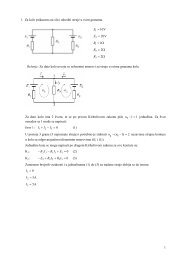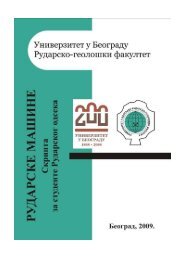KÑига LXXII
KÑига LXXII
KÑига LXXII
Create successful ePaper yourself
Turn your PDF publications into a flip-book with our unique Google optimized e-Paper software.
50<br />
RAJKA RADOIČIĆ & DIVNA JOVANOVIĆ<br />
by very coarse breccia, large clasts (up to tens of cm)<br />
that include those of Liassic limestones, one with<br />
Involutina liassica.<br />
nearly the time equivalent of the “Passée Jaspeuse”<br />
Unit sensu GORIČAN (1994), from which partly differs<br />
in lithology because described “Passée Jaspeuse” is<br />
based on the succession in one of subaxial basin belts.<br />
Donja Lastva succession<br />
Part of the axial Donja Lastva succession, older<br />
than the sediments with I. farinacciae, is not well<br />
exposed. In the limestone, estimated at a few tens<br />
meters lowerward, the early Liassic species Involutina<br />
turgida occurs (KRISTAN–TOLLMANN & COLWELL<br />
1992). I. farinacciae is associated with A. martana,<br />
?Mesoendothyra and some other small foraminifera.<br />
Upward (not measured) in the laterally outcropped<br />
resedimented ooidal limestone, Aalenian–?Bajosian<br />
Gutnicella cayeuxi occurs.<br />
Fig. 1. Microbreccia from the Liassic sequence of the<br />
Verige Section.<br />
The tests of I. farinacciae (forms A and B, D =<br />
0.297–0.396 mm, thickness of test 0.138–0.247 mm,<br />
4–6 whorls) are commonly poorly preserved, they are<br />
more or less recrystallized and not infrequently barely<br />
recognizable.<br />
A Liassic sequences similar in lithology and thickness<br />
to that of Verige, are Liassic sequences of the<br />
Crisanti succession (Sicily) and the Koziakas of<br />
Pindos, Greece (a clast bearing G. tolmmanni is also<br />
from Lower Liassic breccia – Fig. 2).<br />
Fig. 2. The clast of the Triassic limestone with Galleanella<br />
tolmmanni in the Liassic breccia of the Koziakas succession,<br />
Pindos, Greece.<br />
The Liassic sequence of Vrmac–Verige Belt, the<br />
inner distally-proximal succession, is the time or<br />
The discussion concerning the<br />
paleogeography of Montenegro–Albania<br />
border region (the Scutari–Peć<br />
Lineament)<br />
SUESS (1901) defined the Dinarides as a mountain<br />
chain extending from the south of the Eastern Alps,<br />
along the Adriatic and Ionian Seas and across the<br />
Aegean Sea, to the Taurides in Turkey. CVIJIĆ (1901)<br />
described a mild deviation of the Dinaric fold structures<br />
from NW to SE to E and NE, beginning from Njeguši<br />
to Scutari and further northward (the Dinaric Carbonate<br />
Platform! area). The name of the phenomenon “’Scharung”<br />
was borrowed from E. Suess, who used it to<br />
designate an identical structural feature (CVIJIĆ 1901, p.<br />
106). The name Dinarides (CVIJIĆ 1924, p. 107) was<br />
used only for the Dinaric Mountain System extending<br />
to “the known deviation at Scutari”, where the Dinaric<br />
and the Pindos System are in “collision”. KOBER (1929)<br />
also suggested that the transversal line Scutai–Peć<br />
separates the Dinarides from the Helenides. According<br />
to CVIJIĆ (1924, fig. 88: cusp; Fig. 3), two outhers<br />
Dinaridic units are not involved by “collision”: the<br />
Adriatic Carbonate Platform (ACP) that continues from<br />
Montenegro throughout Albania (Kruja) and Greece<br />
(Gavrovo) and the basinal Budva–Krasta Unit.<br />
Numerous publications, however, ignore this information<br />
and designate the Adriatic Carbonate Platform and<br />
the Budva Basin, as Dinarides and their prolongation in<br />
Albania, as Helenides.<br />
The paleogeography of this area of the Dinarides<br />
formed on the inherited tectonic potentially active<br />
prealpine pleogeographic scenario which resulted in a<br />
different arrangement of the paleogeographic units<br />
westward and eastward of a paleostructure, that controlled<br />
the geological history of the region (for neotectoonic<br />
activity see KISSEL et al. 1995; MAROVIĆ &<br />
DJOKOVIĆ 1995)


